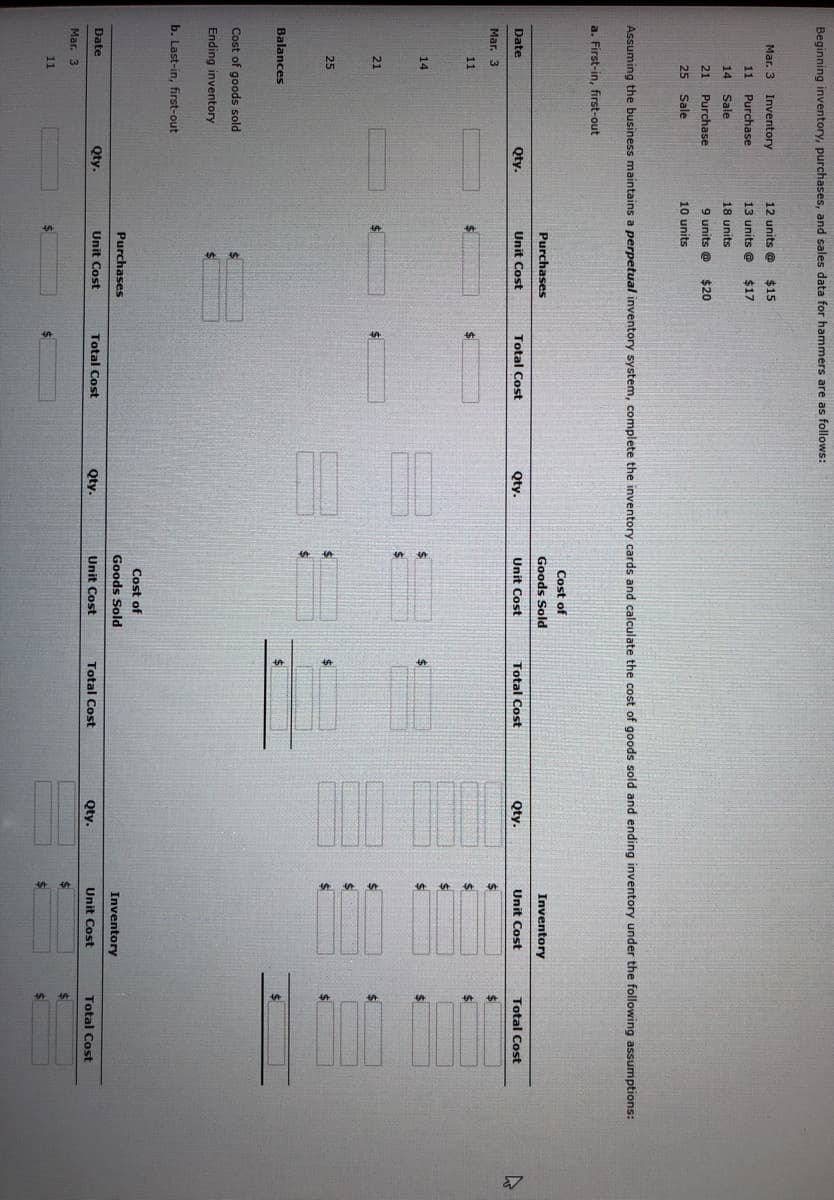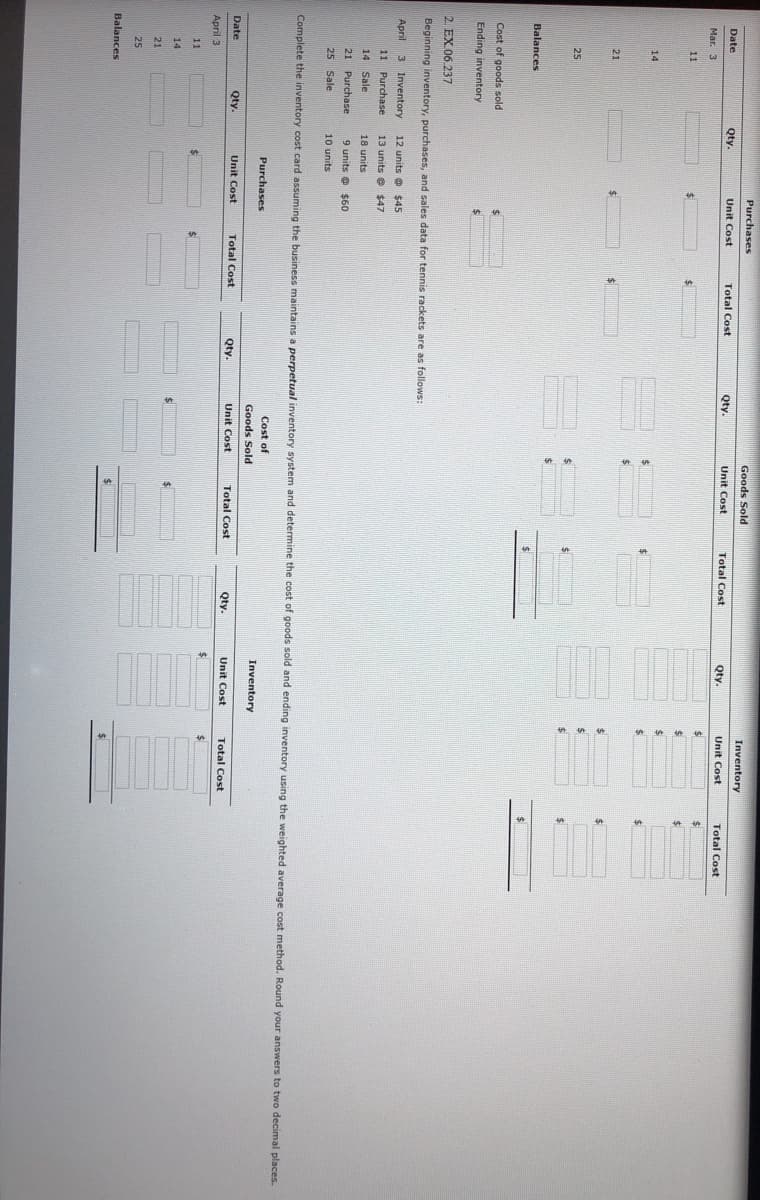Mar. 3 Inventory 12 units @ $15 11 Purchase 13 units @ $17 14 Sale 18 units 21 Purchase 9 units @ $20 25 Sale 10 units Assuming the business maintains a perpetual inventory system, complete the inventory cards and calculate the cost of goods sold and ending inventory under the following assumptions: a. First-in, first-out Cost of Purchases Goods Sold Inventory Date Qty. Unit Cost Total Cost Qty. Unit Cost Total Cost Qty. Unit Cost Total Cost Maг. 3 $4 $4 11 24 24 14 24 21 25 Balances $4 Cost of goods sold Ending inventory b. Last-in, first-out Cost of Purchases Goods Sold Inventory Date Qty. Unit Cost Total Cost Qty. Unit Cost Total Cost Qty. Unit Cost Total Cost Mar. 3 $4 2$4 11
Mar. 3 Inventory 12 units @ $15 11 Purchase 13 units @ $17 14 Sale 18 units 21 Purchase 9 units @ $20 25 Sale 10 units Assuming the business maintains a perpetual inventory system, complete the inventory cards and calculate the cost of goods sold and ending inventory under the following assumptions: a. First-in, first-out Cost of Purchases Goods Sold Inventory Date Qty. Unit Cost Total Cost Qty. Unit Cost Total Cost Qty. Unit Cost Total Cost Maг. 3 $4 $4 11 24 24 14 24 21 25 Balances $4 Cost of goods sold Ending inventory b. Last-in, first-out Cost of Purchases Goods Sold Inventory Date Qty. Unit Cost Total Cost Qty. Unit Cost Total Cost Qty. Unit Cost Total Cost Mar. 3 $4 2$4 11
Cornerstones of Financial Accounting
4th Edition
ISBN:9781337690881
Author:Jay Rich, Jeff Jones
Publisher:Jay Rich, Jeff Jones
Chapter6: Cost Of Goods Sold And Inventory
Section: Chapter Questions
Problem 67APSA: Inventory Costing Methods Andersons Department Store has the following data for inventory,...
Related questions
Topic Video
Question

Transcribed Image Text:Beginning inventory, purchases, and sales data for hammers are as follows:
Mar. 3
Inventory
12 units @
$15
11
Purchase
13 units @
$17
14
Sale
18 units
21
Purchase
9 units @
$20
25
Sale
10 units
Assuming the business maintains a perpetual inventory system, complete the inventory cards and calculate the cost of goods sold and ending inventory under the following assumptions:
a. First-in, first-out
Cost of
Purchases
Goods Sold
Inventory
Date
Qty.
Unit Cost
Total Cost
Qty.
Unit Cost
Total Cost
Qty.
Unit Cost
Total Cost
Mar. 3
11
%$4
%24
14
24
24
21
24
25
$4
Balances
$4
$4
Cost of goods sold
Ending inventory
b. Last-in, first-out
Cost of
Purchases
Goods Sold
Inventory
Date
Qty.
Unit Cost
Total Cost
Qty.
Unit Cost
Total Cost
Qty.
Unit Cost
Total Cost
Mar. 3
11

Transcribed Image Text:Purchases
Goods Sold
Inventory
Date
Qty.
Unit Cost
Total Cost
Qty.
Unit Cost
Total Cost
Qty.
Unit Cost
Total Cost
Mar. 3
11
24
14
%24
%24
21
24
24
25
Balances
Cost of goods sold
Ending inventory
2. EX 06.237
Beginning inventory, purchases, and sales data for tennis rackets are as follows:
April 3 Inventory
12 units e $45
11
Purchase
13 units e $47
14
Sale
18 units
21
Purchase
9 units e $60
25 Sale
10 units
Complete the inventory cost card assuming the business maintains a perpetual inventory system and determine the cost of goods sold and ending inventory using the weighted average cost method. Round your answers to two decimal places.
Cost of
Purchases
Inventory
Goods Sold
Date
Qty.
Unit Cost
Total Cost
Qty.
Unit Cost
Total Cost
Qty.
Unit Cost
Total Cost
April 3
11
14
21
25
Balances
Expert Solution
This question has been solved!
Explore an expertly crafted, step-by-step solution for a thorough understanding of key concepts.
This is a popular solution!
Trending now
This is a popular solution!
Step by step
Solved in 3 steps with 6 images

Knowledge Booster
Learn more about
Need a deep-dive on the concept behind this application? Look no further. Learn more about this topic, accounting and related others by exploring similar questions and additional content below.Recommended textbooks for you

Cornerstones of Financial Accounting
Accounting
ISBN:
9781337690881
Author:
Jay Rich, Jeff Jones
Publisher:
Cengage Learning

Financial And Managerial Accounting
Accounting
ISBN:
9781337902663
Author:
WARREN, Carl S.
Publisher:
Cengage Learning,

Financial Accounting
Accounting
ISBN:
9781337272124
Author:
Carl Warren, James M. Reeve, Jonathan Duchac
Publisher:
Cengage Learning

Cornerstones of Financial Accounting
Accounting
ISBN:
9781337690881
Author:
Jay Rich, Jeff Jones
Publisher:
Cengage Learning

Financial And Managerial Accounting
Accounting
ISBN:
9781337902663
Author:
WARREN, Carl S.
Publisher:
Cengage Learning,

Financial Accounting
Accounting
ISBN:
9781337272124
Author:
Carl Warren, James M. Reeve, Jonathan Duchac
Publisher:
Cengage Learning


Financial Accounting
Accounting
ISBN:
9781305088436
Author:
Carl Warren, Jim Reeve, Jonathan Duchac
Publisher:
Cengage Learning

Principles of Accounting Volume 1
Accounting
ISBN:
9781947172685
Author:
OpenStax
Publisher:
OpenStax College